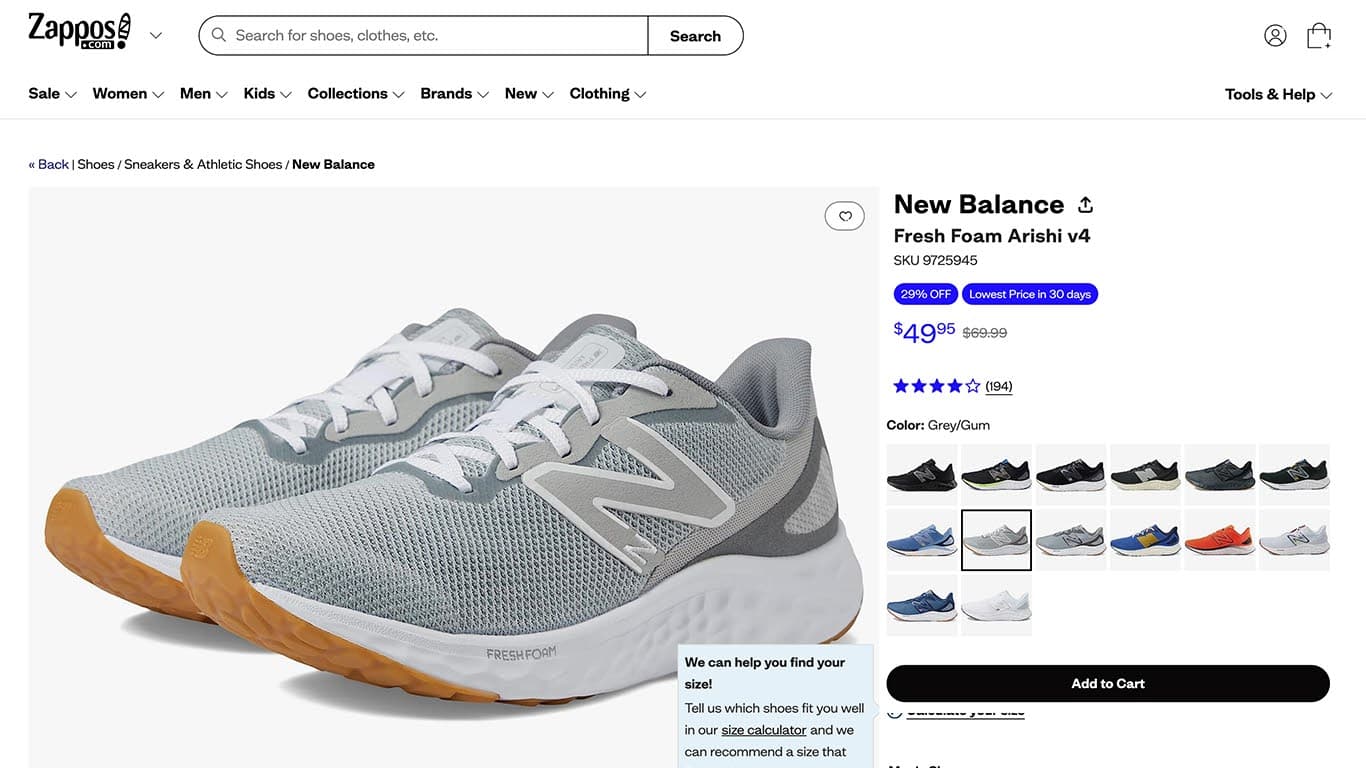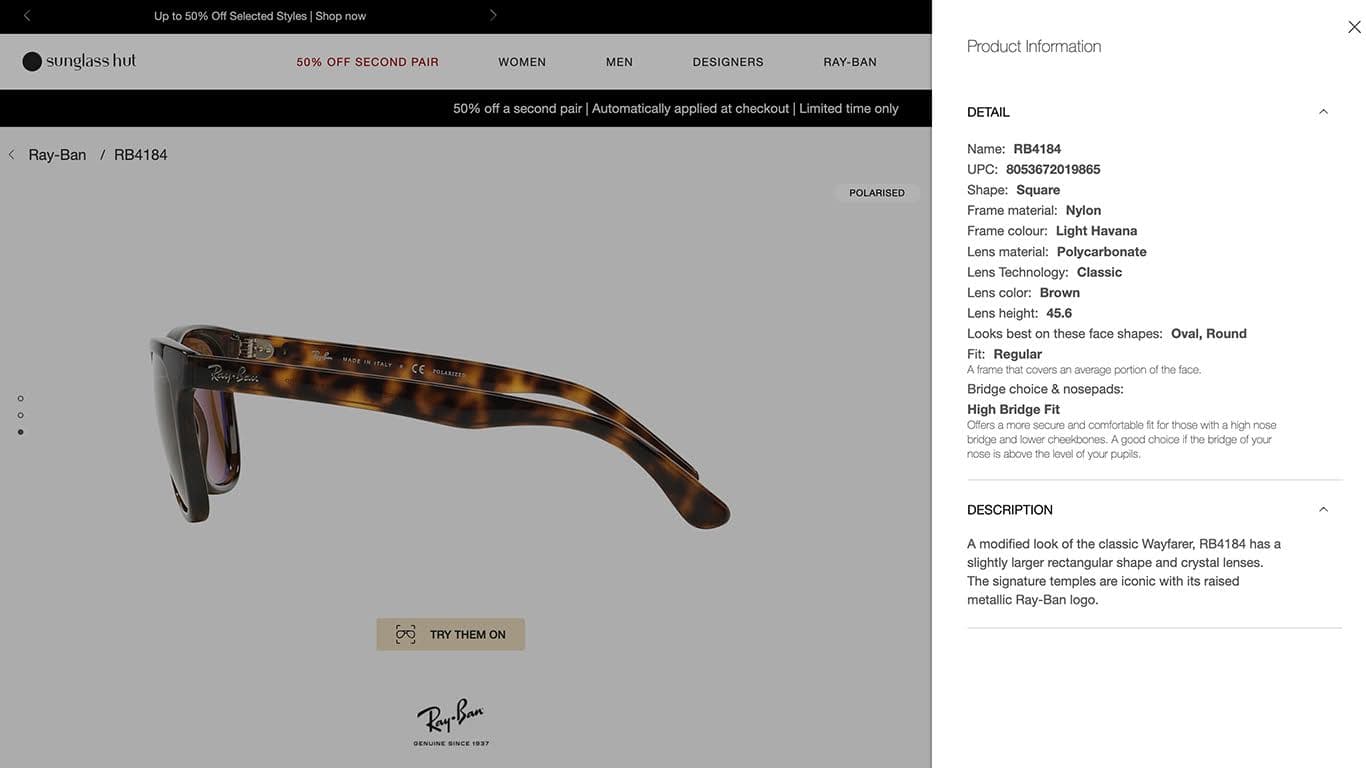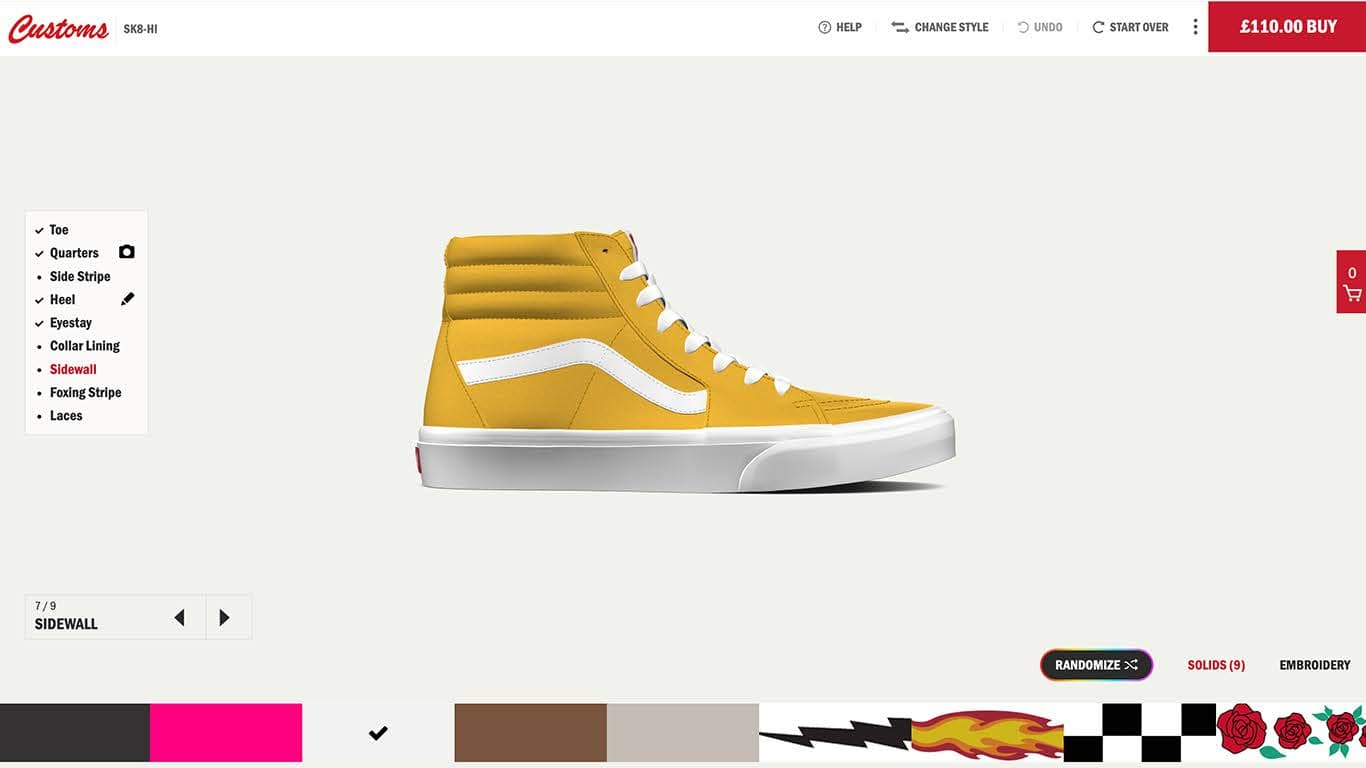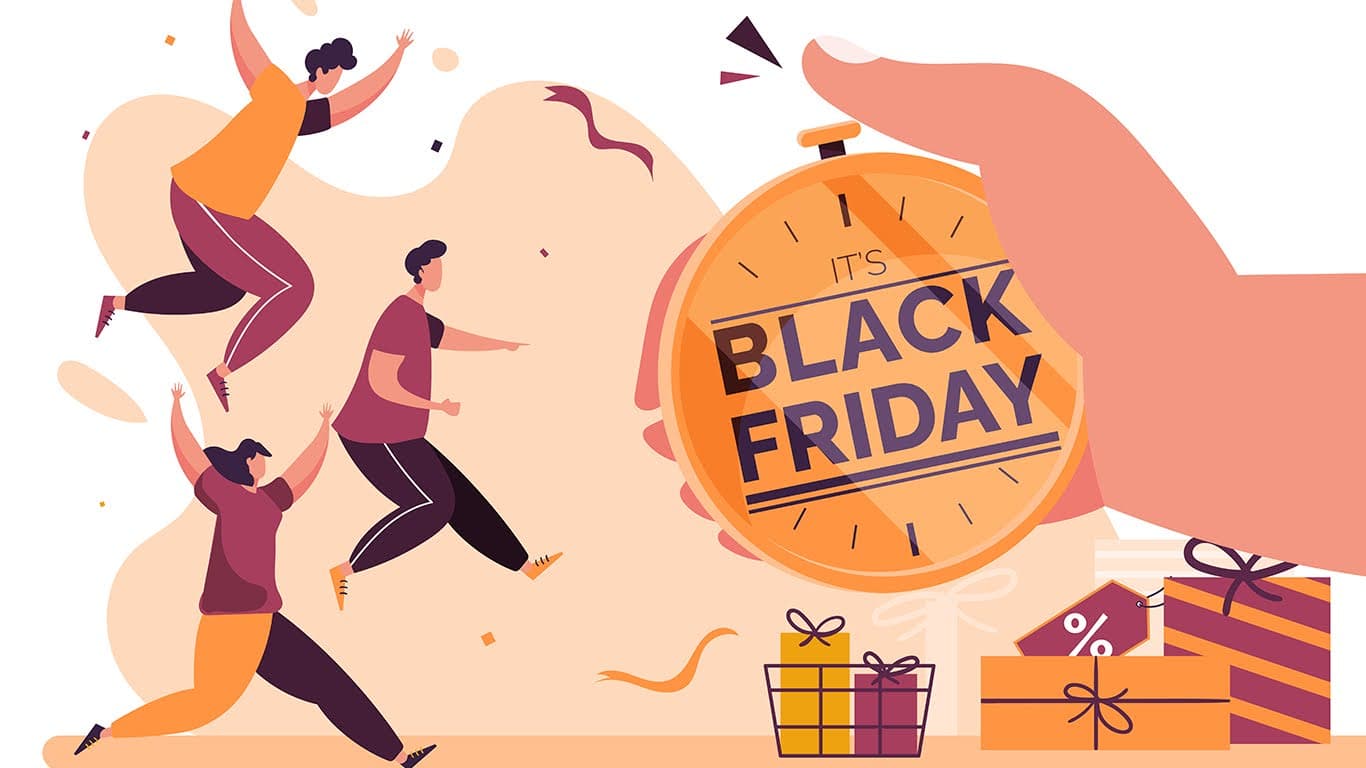
8 Proven Conversion Tactics for Your Product Pages in 2024 (with examples)
When it comes to ecommerce, the most important page you can make is your product page. You can optimise your ads for click-through rate (CTR) as much as you like, but if your product page’s conversion rate (CVR) is low, you’ll struggle.
In 2024, customers expect a high-quality online experience, to get important information easily, and, in a highly distracted world, to find a product that stops them scrolling. At ShopAR, we’re focused on new ways to help clients increase their product page CVR.
In this article, we’ll be covering the benefits of product images, videos and descriptions. We’ll look at the pros and cons of social proof, personalisation and offers. Then we’ll take a deep look into new alternatives such as 3D and AR to see how they’re changing the landscape for product page conversion.
So, without further ado, let’s jump in.
1 - Product Images

Set the scene: What’s the first thing you do when looking at shoes in a footwear store? You pick them up from a shelf and look at the other sides, absorbing how they look from different angles, feeling the texture of the fabric in your hand and checking the size. You might do this with a few before deciding whether to try some on or not.
Ecommerce stores can replicate this initial action by going beyond the thumbnail (the ‘shelf’), featuring images of multiple angles (‘turning’ the shoe in the hand to see the other sides). Let’s take a look at some examples:
Online Retailer | Professional Photos | Customer photos | Video |
|---|---|---|---|
8 | Yes | Style vid | |
6 | Yes | 360 Spin | |
6 | Yes | Walkthrough vid | |
7 | No | 360 Spin | |
4 | No | No |
Notice that not all retailers allow for customer reviews or photos. This could either be taken as a sign that the retailer doesn’t have enough happy customers, fears too many negative reviews, or just wants to keep the emphasis on their own imagery. There’s many pros and cons for and against this practice - see section three for an in-depth analysis on social proof.
Why might additional photos for buying footwear online be an important differentiator for your customer?
To get a sense of the style
If it’s second-hand, to see the quality
To build trust - photos of the product mean it’s more likely to be real
To get a sense of the physical size
Examples of any special features (e.g. light-up, glow-in-the-dark)
Front, side and back: Useful for thumbnails to replicate the ‘shelf’ and quickly browse through lots of styles. But this also gives you a sense of how your new shoe would look to others from different angles.
Inside: To see padding, how chunky the shoe’s tongue is, and an overall sense of comfort.
Close-up: This can easily show the kind of material used, whether it’d be waterproof or easily marked.
How to implement this: Take professional photos of new products and most-popular products. If your library is too big, ask your customers for UGC in trade for prizes. Customers may buy more from you due to the Benjamin Franklin effect.
2 - Product Description

Picture this. You’re scouring the web for a specific product, or you find a product for the first time. The way you’ll get most of your detailed information? by reading the description on the page. From emotive language to hard specifications, it’s all important.
Rishi Rawat, ‘The Shopify Product Page Guy’ of Frictionless Commerce, gives advice on how to approach a product page that you wrote a long time ago:
Re-read the product description from beginning to end so you have the full picture of how you’ve presented this to potential customers.
Read the customer reviews - are they loving or hating a particular feature?
Rewrite your product description based on different levels of product awareness (see the next point, social proof) and add in any highlights customers are picking up on.
There’s other elements to consider too. Does the description fit with your brand’s tone of voice? Do customer reviews echo that same tone of voice? Do the analytics of the page suggest that people don’t spend very long on the page? That can be a sign that your page either looks too long to consume, or isn’t giving enough detail.
Consider SEO here too, and make sure if you sell watches, you use the word ‘watch’ somewhere on the page. Yes, you can use ‘chronometer’, but consider how customers are going to find you too. Having a good conversion rate is one thing, but you need to get leads to your page to convert.
3 - Social Proof

If you’re searching for some new frames for your glasses, there’s a plethora of online retailers you can search through. So how do you make your decision? Word of mouth, or, second-best, customer reviews?
Think about higher-priced products. There are inherent questions customers have, that they’ll need answering before they can be confident about their purchase. Is the glasses or watch retailer an authorised reseller? Are these shoes authentic? Etc. While having lots of customer reviews isn’t always a definitive sign of trust, it can help give weight to product descriptions.
Benefits of customer reviews:
Can give pointers to the customer if the product is the right choice for them
You can add most-loved elements of the product in the reviews into the description
Reviews can help with SEO - If customers are using your keywords positively, you’re doing something right
Other than overhearing conversations, customers can’t see product reviews in a bricks and mortar store, adding an online-only benefit
Downside of customer reviews:
Negative reviews can seriously harm your product’s page, especially if there’s not many reviews to drown out the harshest of critics
Negative reviews are more likely to be common, as it’s the easiest way for unhappy customers to complain. Happy customers are more likely to be content, which doesn’t drive action.
Fake reviews can damage trust in the brand, especially if they become commonplace
Can drive narrative away from main selling points they’d see in-store. E.g. a unisex watch not looking good on a male when the buyer is female, or shoes that didn’t come with a second pair of laces when the customer wants to know about the fit.
Examples: We can see that not all shoe retailers opt for allowing customer reviews on their platform. While customers could look elsewhere for reviews, like TrustPilot or Youtube, unless there’s a pair they’re particularly interested in it’s unlikely they would hunt out reviews for each pair if they’re browsing.
4 - Product Videos
Photos sometimes just don’t cut it. If you’re looking at resellers, then you may come across the same photo on each website. Adding an extra layer of detail with a video can really sell the idea that you’re the go-to provider.

Questions that video can solve:
How heavy is the product? (See someone hold it)
What does the product look like from every angle (360 turning)
What does the product sound like? (e.g. clock ticking)
How easy is it to hold the product? (ergonomics)
Benefits of video: Well-edited video can also increase excitement in a product. Where perfectly-angled photos can show exact areas of a product, a video can use motion, cuts and effects to build a sense of emotion. A new mountain bike might have a pulsing soundtrack with fast cuts, while a tabletop fragrance diffuser might have calming sounds with slow fades.
Downsides to video: If a video is used as a long-form walkthrough to using the product, it may bury the information the viewer is trying to find, slowing them from making a decision.
Examples:
Nike show the product on a model, to give you a sense of style
Natural Twenty Tables uses video as a walkthrough on each feature of the product
Google watch uses sweeping views to set the mood and give alternative views
Guthrie & Ghani use a looping video to show product texture and weight
5 - 3D

While images can show the product in its best light, and video can give you a 360 view of the product, neither allow the customer to hone in to the element they’re more interested in. In a watch, that could be the buckle, the detail in the wrist strap or how detailed the complications are.
3D allows customers to interact in this way, moving around a 3-dimensional recreation of the product, zooming in on any part of the product.
Many of the questions or hesitations customers have can be solved using this technology, as it’s the second-closest method (see Augmented Reality) to getting an overview of the entire product at a glance.
ShopAR specialise in both 3D and AR, making it simple to upgrade your product pages with 3D products that customers can interact with.
6 - Augmented Reality
If you’re a customer looking through a shop window at the latest watches, you have a very limited experience. While you can move around to see details, you can’t look at the back or close up without going in and entering into a sales pitch.

Unlike glasses, watches are usually withheld from prospecting customers until they speak to an associate. Being online only distances them further, with only 2D images (and sometimes video) to show them what they can purchase. 3D allows them to look around the product, but not see how it looks on them.
That’s where Augmented Reality steps in. Using software like ShopAR, the product can be virtually fitted to the customer, so they can see how it would actually look on them, at any angle. They can then see whether the style fits them and their current outfit. It also allows for shareability among their social networks, encouraging word-of-mouth encouragement and building intrigue about the brand for newcomers.
In fact, interacting with products in AR have a 94% higher purchase CVR. [source]
Think about the questions your customers would ask about your range of watches. While questions are usually feature-focused, what do they really want to know?
What people ask | What they actually want to know |
|---|---|
What features does it have? | Does it meet/exceed expectations from my previous watch? |
What colour options are there? | Will it look good on me? |
How big is the strap? | Will it fit me? |
What is the size of the watch face? | Can I easily read the time at a glance? |
What is the material used? | Is it comfortable? |
Can I try it on first? | All of the above |
Notice that most of the underlying questions can’t be answered easily by text description, but only with a physical or virtual try-on.
Let’s take a comparison of the differences in experience we can provide a customer to answer these questions:
| Window shopping | Online product page | Physical Try-On | Virtual Try-On (AR) |
|---|---|---|---|---|
Potential reach | Locals | 1000s | Handful | 1000s |
Interaction | View in 3D 180 | View in 2D/3D | Touch | View in 3D, precisely fitted |
Potential of theft | Low | None | Medium | None |
Social Media Shareability | Poor (poor lighting behind glass) | Basic (link only) | High (if comfortable with associate) | High |
It’s important to note the potential reach here. Bloobloom used Augmented Reality to increase the range of customers they could ‘send’ glasses to for try on. Postage and product availability limited them to local markets. By providing AR try-ons, they were able to cut down the waiting time between discovery and try-on increasing CVR by 10%, and expand to new markets.
While bricks and mortar retailers will keep their watches behind glass to avoid theft, this reduces the likeness of try-ons. While it increases the perceived value, it can deter potential customers who are limited on time. AR bypasses this, allowing for the benefits of try-on without the increased steps that would occur physically.
No wonder 75% brands who use AR say it improves loyalty and customer experience. [source]
How to implement this: ShopAR makes adding AR into your product page super easy, with no need to touch a line of code.
7 - Personalisation

You can segment your customers into different awareness types:
Someone who has never bought a high-end watch before
Someone who already has a watch, but hasn’t heard of yours
Someone who’s shopping around for watches and is highly knowledgeable
Each persona can be individually targeted based on their stage of the buying cycle, brand loyalty and pre-existing knowledge of the product and brand. While this is often built into email marketing campaigns, it’s not such commonplace on product pages. But you can easily ask questions that reveal different insights.
For example, if you asked which category they put themselves in from above and they answered number 1, you could offer a simplified overview of your products and the market. If they answered 2, you could show a comparison against other well-known brands with what makes yours unique. If they answered number 3, you could focus on the specific specs of your watches.
Benefits of personalisation:
You can target prospects using their own customer language
Capture customers at their point in the buying cycle, instead of generalising for everyone, making you adapt to customers, rather than the other way around
The easier you make it for customers to understand your product offering, the more likely they’ll buy
Downsides of personalisation:
There’s extra upfront work for you to target each customer segment
Each page needs 2-3x more written content
This is almost impossible to do if you have a large product library, although if you mix together a generalisation for all products and AI-generated copy, it’s achievable (but be wary of quality, comprehension and accuracy)
Examples:
Here’s a couple of good examples where companies are asking questions upfront to build a more personalised offering to the customer.
The Goldsmiths Watch Buying Guide breaks down the individual elements of watch buying to provide options based on the exact requirements of the buyer. Need a watch around £500? There’s a section for that. Unsure what water-depth you should be looking for There’s a section for that too.
John Lewis is a department store that features mens and womens clothing heavily. The Buying Guide for Mens Shoes is an online version of the in-store experience, that asks general questions first to whittle down options for the buyer.
How to implement this: Think about the questions you could ask your customers. What levels of awareness apply? It’s easy to think up too many or too few segments, so aim for three. You can either build a guide like the examples above, or ask the questions directly on the product page.
8 - Offers

As a customer, you could be looking at a number of different product solutions. Each one has its own pros and cons. However, one is on offer for a limited time. Bam. All level-headed comparison goes out the window. We now have a ticking time limit on your decision.
It’s easy to overlook the power of a time limit as we’ve become so used to it in buying decisions, but it’s an extremely powerful driver in making (or breaking) a sale.
The benefits of offers:
Scarcity makes products desirable
Fear of missing out (FOMO) can be a real motivator to make quick decisions
Customers may come to you without prompt at certain times of the year (New Year Sales, Easter Sales, Black Friday, Cyber Monday)
The downsides of offers:
Those who made the decision to buy too quickly may have regrets, which turn into negative reviews against genuinely good products
They degrade the value of your product. Customers may hold off on purchasing until the next offer.
They affect the going market rate. Competitors may lower their prices to match, creating a downward spiral.
How to implement this: Create a plan to make the most of your offer. Think about how to treat customers who buy during sale times. Analyse your sales data to see if they’re more likely to buy each time you run a sale, then use email marketing to target them specifically with flash sales throughout the year.
Conclusion
If the benefits of 3D or AR pique your interest, take a look at ShopAR.
ShopAR makes it easy to enhance your customer experience with the latest in 3D and Augmented Reality try-on technology without the need for any technical knowledge.